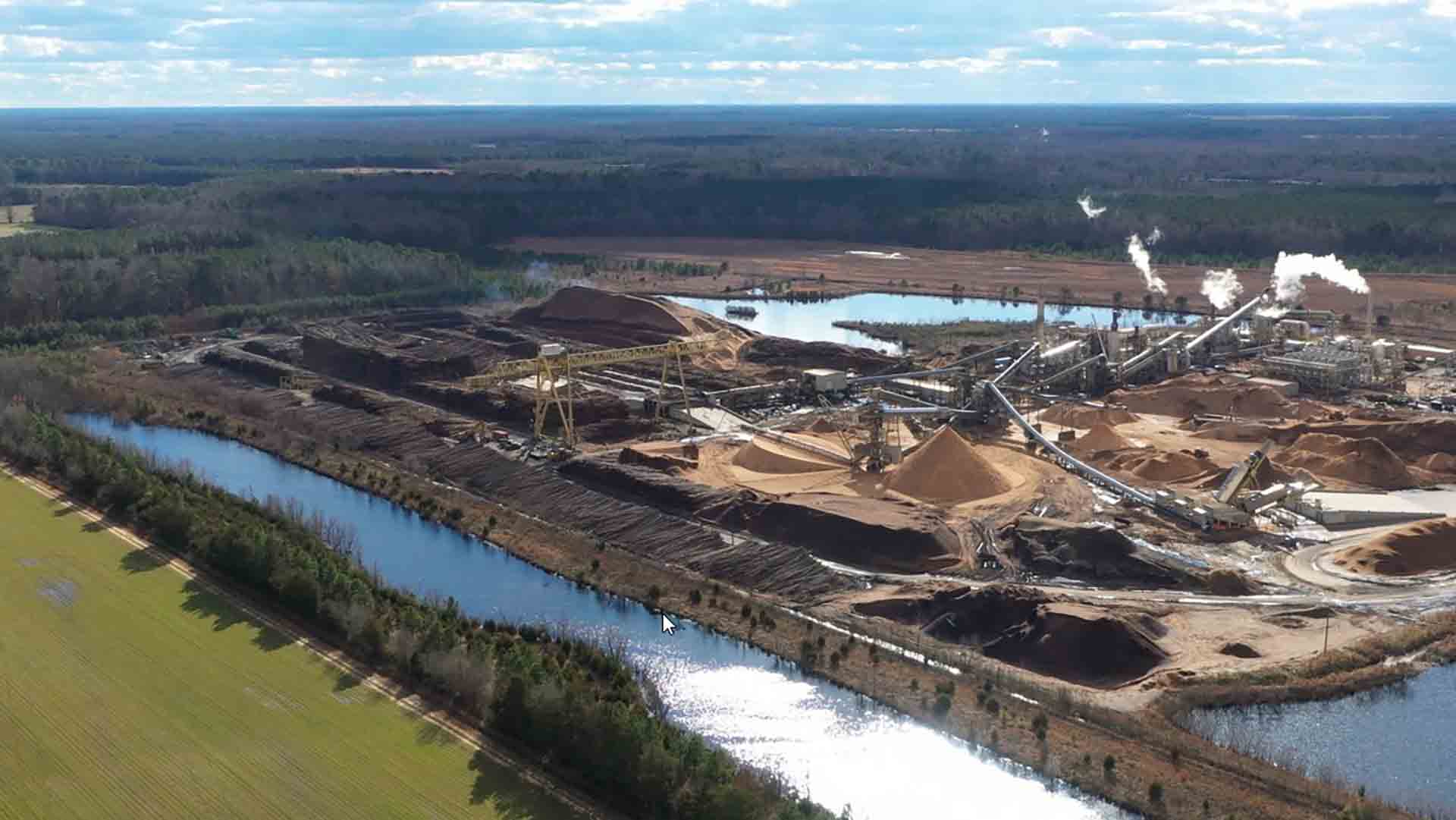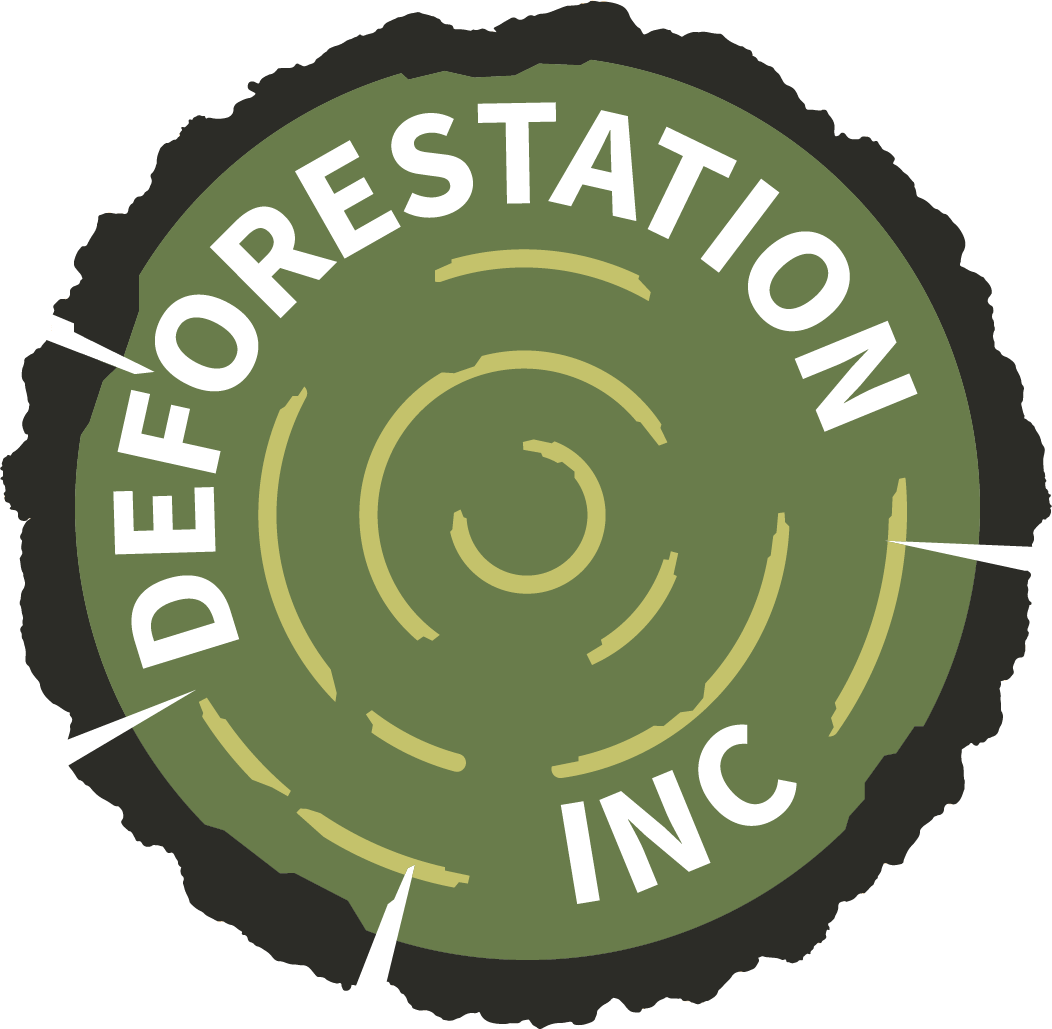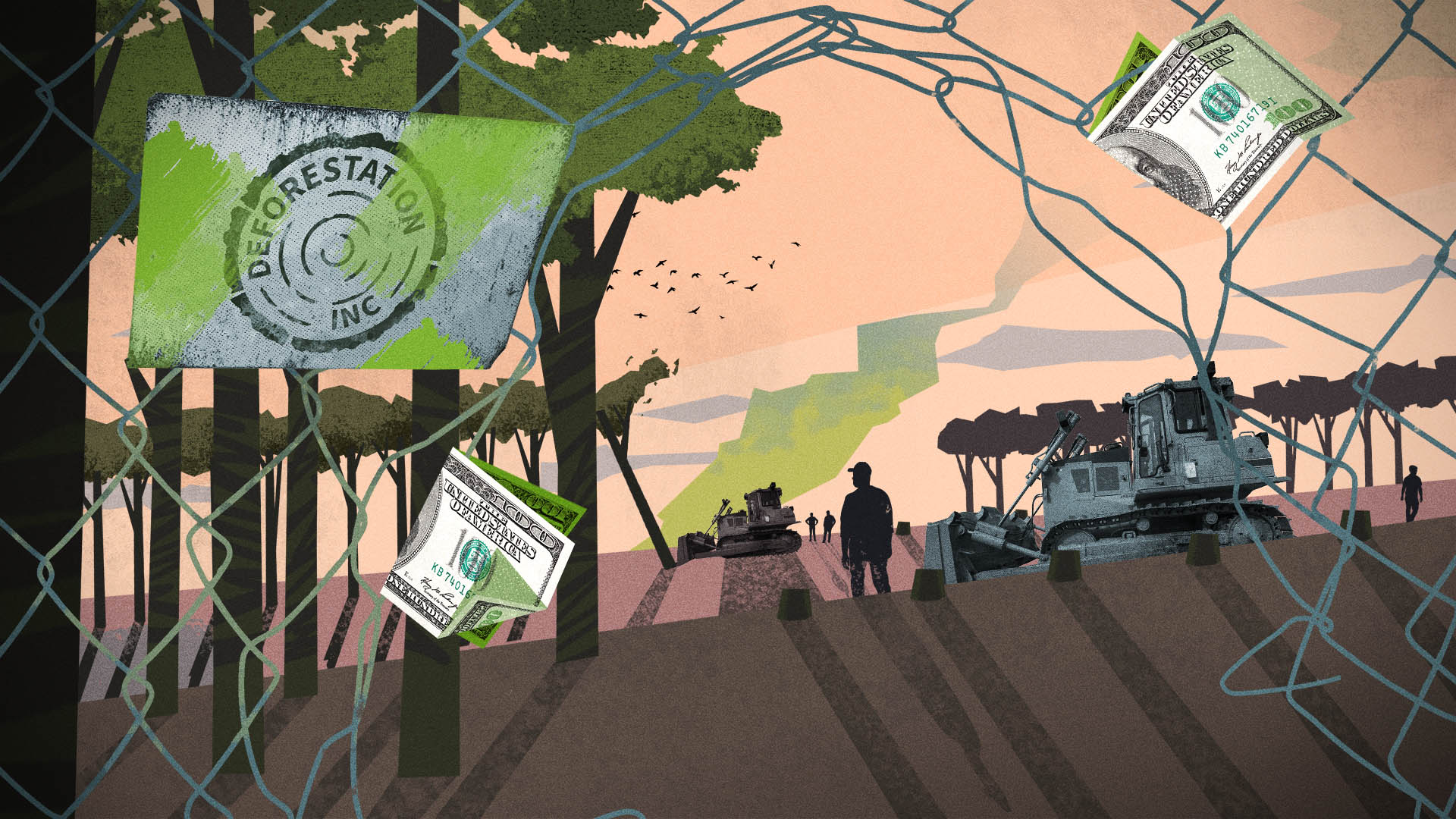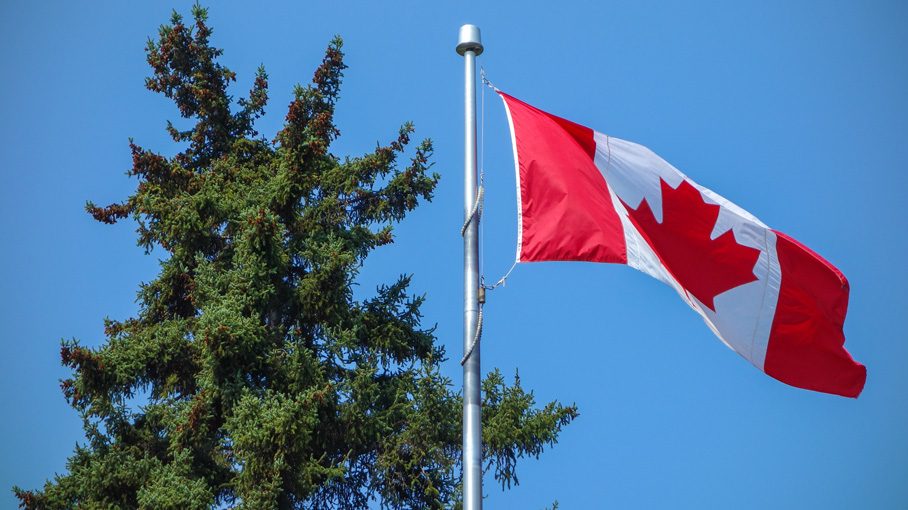Behind the scenes
From US pellet mills to jungles in India, behind the scenes of Deforestation Inc. reporting
Journalists trekked through forests, tracked timber trucks, sifted through dense paper trails and more as part of their work for the global investigation.

Tracing a path from a green label on a cardboard box all the way back to its origins in a faraway forest takes a very different type of reporting.
This was the challenge faced by the team behind ICIJ’s Deforestation Inc. investigation.
Reporters from around the world began by collecting records from multiple sources across 50 countries, including shipping records, auditors’ reports, regulators’ files and leaked tax documents. The team then identified hundreds of cases where environmental auditors, responsible for certifying products as “sustainable,” ignored or failed to recognize glaring environmental damage caused by their clients — timber traders, paper and pulp producers, furniture makers, yacht builders and more.
Then came the fieldwork. As part of the cross-border investigation, reporters tramped Indigenous forestland in western Canada to uncover evidence of clear-cuts. They inspected luxury yachts at boat shows in Fort Lauderdale, Amsterdam and Paris. They staked out wood pellet mills in North Carolina to follow the supply chain to energy plants in the Netherlands. They used drones, followed trucks, spoke to local communities, and so much more.
Here, three of the 140 journalists who worked on Deforestation Inc. take you behind the scenes of their reporting.
CANADA: Asking a First Nations Chief to relive her community’s trauma
By Joan Baxter, Halifax Examiner
If I could have spared Chief Andrea Paul yet another interview probing her painful history with the Paper Excellence-owned Northern Pulp mill that sits on the doorstep of her Pictou Landing First Nation (PLFN) community in northern Nova Scotia, I would have done so.
For months I refrained from contacting Chief Paul, reluctant to ask her to relive what she described in Facebook posts as the “trauma” Northern Pulp caused PLFN. The mill went into hibernation in January 2020 after its proposal for a new effluent treatment system failed to pass muster with the Nova Scotia government. I knew from earlier interviews with Chief Paul that her Indigenous community was just starting to heal from decades of, in her words, “pain and suffering” caused by the mill’s pollution, which has been described as one of Canada’s most egregious cases of environmental racism.
In mid-2022, Chief Paul posted that when Paper Excellence executives tried to “engage” her and garner her support to have the pulp mill reopened. She said it felt as if her “abuser” was at her door again.
And so for months I avoided contacting Chief Paul, instead pursuing other angles of the Paper Excellence story that I was working on for the Halifax Examiner together with journalists from CBC and Glacier Media in Canada, and Radio France and Le Monde in France, as part of the ICIJ-led Deforestation Inc. project.
We delved into the complex and obscure corporate structure of Paper Excellence, owned by Jackson Wijaya, and examined its links with Asia Pulp & Paper (APP) and the Sinar Mas Group, owned by his family. Thanks to a whistleblower who had once worked for APP, we were able to challenge Paper Excellence and APP claims that the two corporations operated completely independently of each other. Our investigation also looked at APP’s poor financial and environmental record in Asia, and Paper Excellence’s meteoric growth in Canada, where it now controls 21% of the pulp and paper market and 22 million hectares of forested land — an area four times the size of the province Nova Scotia.
But in the final weeks of the investigation, I realized I couldn’t report on Paper Excellence in Canada without including the story of how the corporation had dealt with PFLN. And who could tell that if not Chief Paul?
And so, I started sending her messages. At first, she didn’t reply. And then finally she did, agreeing to an interview.
Chief Paul’s account of her experience with Paper Excellence’s Northern Pulp mill was wrenching, and there were parts of it she asked I not write because they were just too personal and painful. But the interview turned out to be a crucial part of the Paper Excellence story in Canada, powerful and important enough for a stand-alone article in the Deforestation Inc. series.
Editor’s note: Paper Excellence told the Halifax Examiner that the company “engaged with Chief Andrea Paul and the Pictou Landing First Nation to ensure that their views and perspectives were understood and taken into consideration in any potential future operations of the Pictou mill.”
Joan Baxter is a journalist at the Halifax Examiner and the author of seven books. She wrote “The Mill: Fifty Years of Pulp and Protest,” about the Paper Excellence mill in Nova Scotia.
INDIA: Trekking through remote jungles to uncover faltering reforestation sites
By Amitabh Sinha, The Indian Express
Finding a place where forests are being cut down to make way for infrastructure or industrial projects is not a difficult task in India. A seven-year-old “compensatory afforestation” law allows companies to do this legally, so long as they create a new forest elsewhere. But the program has been subject to much debate, and officials concede its implementation is problematic.
For our reporting, we visited some of these compensatory afforestation sites in Chhattisgarh and Odisha, two states in central and eastern parts of the country with very heavy forest cover. We visited at least five compensatory afforestation sites, two accompanied by forest officials and three with local contacts.
There are heavily forested areas barely an hour’s drive from Raipur, the capital city of Chhattisgarh state, which is at least 40% forest. The compensatory afforestation sites were deep inside the jungles and only one was accessible by car. We had to walk to reach the others.
On the way, we passed through the site of a new highway being constructed to connect Raipur with the coastal city of Visakhapatnam in neighboring Andhra Pradesh state. Large swathes of forest were being cleared for the 60-meter (200-foot) highway (in forested areas, the width of the highway was reduced to 45 meters). Piles of numbered logs lay unattended. The wood was legally logged and waiting to be transported to markets for auction — a forest official assured me the logs do not get misplaced or stolen, and there is a method to track each one. We also saw several large trucks carrying logged wood.
The compensatory afforestation sites were a revelation. In stark contrast to the lush green, dense forests that were being cut down, these sites were a patchwork of rocks and sand. Nothing seemed to have ever grown over them. India’s compensatory afforestation law makes it mandatory for the agencies to provide non-forest land in compensation for the forests being cut down. But it does not say anything about the quality of land provided in compensation. As a result, much of the land designated for compensatory afforestation is inferior. Land is a scarce resource, and it is difficult to get good-quality land locked up for afforestation purposes.
It was evident the plantations on the sites would be difficult to sustain. Three of the recently planted sites were struggling to sustain themselves. One four-year-old plantation, next to an established forest, had developed well. A local contact in Odisha took me to a site, which he said had been planted twice — once about 10 years ago, before the law kicked in, and then again six years ago. The site had good growth, but it was difficult to verify his claims because the records from the period before the law came into force are not very reliable. When I checked his account with a forest official, I was told it was unlikely but not impossible.
Local contacts flagged several issues with the compensatory afforestation program — the selection of unsuitable species, monoculture, fake plantations (I could not find any examples) and many plantations’ failure to sustain. Forest officials flagged another set of problems — pressures from humans and animals, poor quality of land, and the shortage of manpower to monitor and nurture plantations.
Seven years is too short a time to assess the success, or otherwise, of an afforestation exercise. Good-quality forests can take three to four decades, sometimes more, to develop. But there are several red flags in the compensatory afforestation program that threaten to derail its success.
Amitabh Sinha is a deputy editor at The Indian Express, where he writes about the environment and climate change, among other topics.
GERMANY: From American forests to EU power plants, tracking the impact of Europe’s hunger for wood
By Petra Blum, WDR
Reporting for the ICIJ-led Deforestation Inc. project was different from all the other cross-border investigations I had worked on before: It was personal. My family has owned a forest for generations — now it is dying on my watch, slowly and gradually. Germany’s long, hot and dry summers have taken their toll. When we go without as much as a single drop of rain for weeks and months, many trees don’t make it. Wildfires and bugs degrade dried-up forests even further.
My trees are not the only ones suffering in Germany, or Europe. What’s going to happen when forests can no longer withstand climate change? And why do governments still cut down trees and burn the wood when forests offset a large portion of our carbon emissions?
With these unsettling questions in mind, we set out to explore the so-called “woody biomass” policy of the EU. We soon found that it simply meant that wood was being cut and burned at record levels in the bloc for heat and energy. During our research, we learned from sources that Europe’s desire for wood (labeled “biomass”) was affecting other regions of the world, including forest-rich regions of the United States. To see this with our own eyes we went on a week-long road trip through the U.S. states of Virginia and North Carolina, home to America’s wood pellet industry. Activists from NGOs had told us what to expect: Pine plantations; mills that pelletize wood; and, as a consequence, degraded landscapes riddled with clear-cuts. In a nutshell: Deforestation for energy production to fuel Europe, Asia, and elsewhere.
Wood pellet companies are adamant their pellets are carbon neutral, insist that forests are being regrown and frequently emphasize the sustainability of their business practices. But whistleblower accounts and investor lawsuits had already dispelled that narrative, allowing a glimpse into an industry that seemed far from sustainable. After months of background conversations, preparation and research, in January 2023 we finally got on a plane to the U.S. Equipped with cameras and drones, we wanted to show our audience what had previously been hidden: The industrialized exploitation of forests in places thousands of miles away from the EU, to feed Europe’s hunger for energy.
The pellet factories are carefully shielded on private land, so getting pictures of them wasn’t easy at first. Our best option was to stake them out and film what went into and came out of the pellet mills. Our presence out front of one mill in Virginia didn’t go unnoticed. Soon after we arrived on our first day of filming, the company that owned the mill made sure we knew we weren’t welcome. Staff watched us closely and when we persisted, the company called the police.
On the second day, as we filmed outside a mill in North Carolina with the same owner, we saw big, beautiful timber logs being delivered by the truckload. When a car approached us, we realized the company had sent someone to watch us. The representative who approached us seemed emotional, upset even. In a somewhat heated exchange, he made it clear he didn’t want journalists filming the trucks, or the logs they were bringing into the mill.
It made us wonder: Why would the pellet producer try to get rid of us if everything they did was as sustainable as they claimed?

One particular scene we shot on that day has stuck with me ever since. We filmed an interview with Rita Frost from Dogwood Alliance, an environmental nonprofit. Against the backdrop of the mill’s smokestack, with timber trucks roaring behind us, we shot the interview in front of a nearby solar panel field. During our conversation, Frost succinctly debunked the myth of carbon-free wood combustion. Almost casually, she also mentioned to me why we had happened to stand in front of a solar field, here, in North Carolina, the home of the pellet industry. The state itself did not believe in the sustainability of wood combustion. While sacrificing its own forests by the truckload to ship to other continents, North Carolina was supporting the development of solar fields instead.
We found many more solar fields in the area, which nobody tried to keep us from filming. Nobody called the police while our drones captured footage of solar panels neatly nestled in the landscape.
Rewatching the footage, it struck me that what we found on the ground in North Carolina was more than an elusive company trying to hide what it was doing. We had a brief brush with the battlefield that is the future of energy production.
After the trip, we went home with more than just footage. We had learned and seen a lot. We met extraordinary people, some of whom were scared to speak up because they feared being ostracized in their communities, while others told us frankly how the pollution of the pellet mills made their lives miserable. We are grateful to all the members of the communities, the researchers and the activists who helped us understand what was going on in their home region and how they were affected by the EU’s biomass policy.
Petra Blum is an author, university professor, and reporter with WDR, a German public broadcaster. Blum has participated in several cross-border investigations with ICIJ, including the Pandora Papers and the Panama Papers.
These excerpts have been edited for brevity and clarity.



